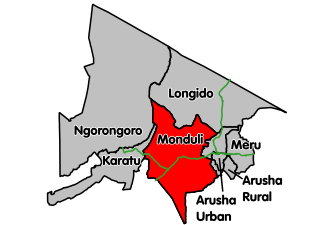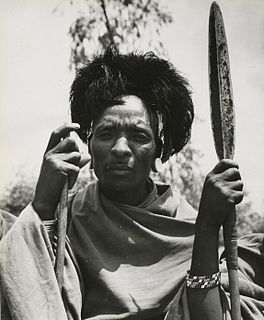Related Research Articles

Swahili, also known as Kiswahili, is a Bantu language and the first language of the Swahili people. It is a lingua franca of the African Great Lakes region and other parts of eastern and south-eastern Africa, including Kenya, Tanzania, Uganda, Rwanda, Burundi, some parts of Malawi, Somalia, Zambia, Mozambique and the Democratic Republic of the Congo (DRC). Comorian, spoken in the Comoros Islands, is sometimes considered to be a dialect of Swahili, though other authorities consider it a distinct language.

Gers is a department in the Occitanie region of Southwestern France. Named after the Gers River, its inhabitants are called the Gersois and Gersoises in French. In 2016, it had a population of 190,664.

Pemba Island is a Tanzanian island forming part of the Zanzibar Archipelago, lying within the Swahili Coast in the Indian Ocean.

The Khmu are an ethnic group of Southeast Asia. The majority (88%) live in northern Laos where they constitute the largest minority ethnic group, comprising eleven percent of the total population. Alternative historical English spellings include Kmhmu, Kemu and Khammu, among others.

Singida is one of the regions of Tanzania. The regional capital is the municipality of Singida. The region is bordered to the north by Shinyanga Region, Simiyu Region and Arusha Region, to the northeast by Manyara Region, to the east by Dodoma Region, to the southeast by Iringa Region, to the southwest by Mbeya Region and to the west by Tabora Region.

Iringa is one of Tanzania's 31 administrative regions. The regional capital is Iringa. The region's population is 941,238. It is primarily agricultural and boasts the second-highest per-capita GDP in the country.

Tabora Urban is one of the seven districts in the Tabora Region of Tanzania. This district is mostly the city of Tabora and its suburbs. It is bordered almost completely by the Uyui District. It has a small border with Nzega District to the north. Its administrative seat is the city of Tabora.

Monduli District is one of the seven districts of the Arusha Region of Tanzania. It is located in the northeastern section of the country. It is bordered to the north by Longido District, to the east by Arusha Rural District, to the south by the Manyara Region and to the west by Ngorongoro District and Karatu District. The town of Monduli is the administrative seat of the district. According to the 2002 Tanzania National Census, the population of the Monduli District was 185,237. By 2012, the population of the district was 158,929. The population decreased, as Longido District was split off.

Iramba is one of the six districts of the Singida Region of central Tanzania. It is bordered to the Northwest by the Shinyanga Region, to the North by Simiyu Region, to the east by the Mkalama District, to the South by Ikungi District and to the West by the Tabora Region. Its administrative seat is the town of Kiomboi].

The Turu are an ethnic and linguistic group based in the Singida Region of north-central Tanzania who speak the Bantu Kinyaturu. In 1993, the Turu population was estimated to number 556,000. The current population of the Turu is now over 1,000,000.
The languages of the African Union are languages used by citizens within the member states of the African Union (AU). For languages of the institution, see African Union: Languages.
The Mikea are a group of Malagasy-speaking horticulturalists and foragers who are often described as the lowland hunter-gatherers of Madagascar. They inhabit the Mikea Forest, a patch of mixed spiny forest and dry deciduous forest along the coast of southwestern Madagascar. The Mikea are predominantly of Sakalava origin, although the term describes a lifestyle rather than an ethnic group per se, and individuals from a variety of Malagasy ethnic groups are found among the Mikea. The family encampments of the Mikea shift from prime corn planting territory at the edge of the forest in the rainy season to the interior forest rich with tenrecs and other game in the dry season, when the community becomes highly dependent on spongy tubers to meet their daily demand for water. Their lifestyle is interdependent with that of their neighboring Vezo fishermen and the Masikoro farmers and herders, with whom they trade products caught, foraged or cultivated in the forest. Many Mikea also occasionally engage in paid work such as guarding the zebu herds or tending the corn fields of others.
Digo (Chidigo) is a Bantu language spoken primarily along the East African coast between Mombasa and Tanga by the Digo people of Kenya and Tanzania. The ethnic Digo population has been estimated at around 360,000, the majority of whom are presumably speakers of the language. All adult speakers of Digo are bilingual in Swahili, East Africa's lingua franca. The two languages are closely related, and Digo also has much vocabulary borrowed from neighbouring Swahili dialects.

Middlepits is a village in Kgalagadi District of Botswana. It borders South Africa and has an immigration border post.

Kutkai Township is a township of Muse District in the Shan State of eastern Burma. The principal town is Kutkai.
Magugu is an administrative ward in the Babati district of the Manyara Region of Tanzania. According to the 2002 census, the ward has a total population of 23,682. It is famous for its aromatic rice.

Kinyangiri is an administrative ward in the Mkalama District of the Singida Region of Tanzania. According to the 2002 census, the ward had a total population of 18,838. According to the 2012 census, the population had decreased to 13,475.
Mudida is an administrative ward in the Singida Rural district of the Singida Region of Tanzania. According to the 2002 census, the ward has a total population of 12,321.
Iramba, also known as Nilamba is a Bantu language of spoken by the Nilamba and Iambi people of the Iramba District in Singida Region of Tanzania.
Zaramo is a Niger-Congo language, formerly primary language of the Zaramo people of eastern Tanzania. Zaramo is also known as Zalamo, Kizaramo, Dzalamo, Zaramu, Saramo and, Myagatwa. The language is critically endangered. The ethnic population of the Zaramo people reaches about 200,000, yet there are only a few elderly speakers remaining.
References
- ↑ "2002 Population and Housing Census General Report". Government of Tanzania. Archived from the original on 2006-06-08. Retrieved 2009-05-22.
Coordinates: 4°33′S34°51′E / 4.550°S 34.850°E
| This Singida Region location article is a stub. You can help Wikipedia by expanding it. |